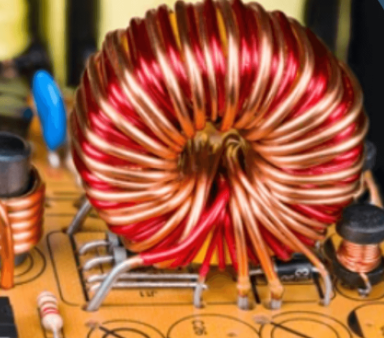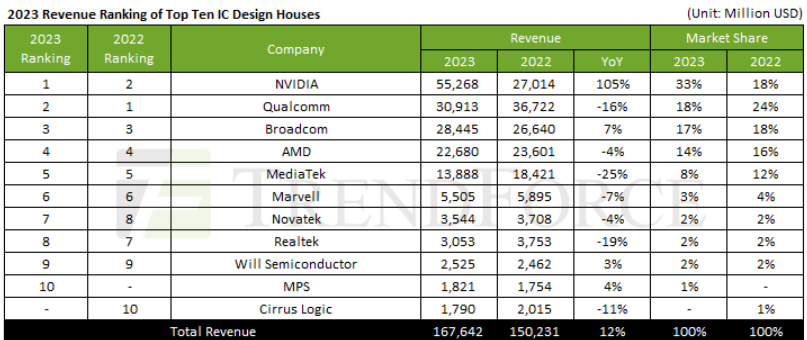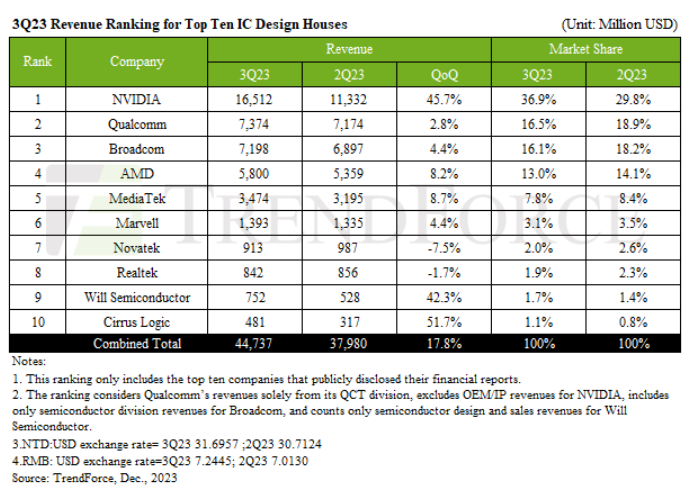Top 10 Integrated Circuit (IC) design services suppliers in the world in 2023
Integrated circuit, known as IC, chips, or microchips, is the foundation of most modern electronics technology. Chips are small as well as simplified design and manufacturing, for that they are manufactured on a single conductive piece of material. Today there are many companies that provide the full range of IC services from design through manufacturing.
To assist you in your supplier search, we have compiled information of top 10 integrated circuit design services suppliers in the world in this article.
1. TSMC
Taiwan Semiconductor Manufacturing Company limited (TSMC) is a Taiwanese multinational semiconductor contract manufacturing and design company dedicated IC foundry. It is the world’s first dedicated semiconductor foundry and launched the semiconductor industry’s first 0.13-micron (µm) low-k, copper system-on-a-chip (SoC) process technology.
In 2022, the annual capacity of the manufacturing facilities managed by TSMC exceeded 15 million 12-inch equivalent wafers. And it makes chips for customers with process nodes from 3 microns to 3 nanometres, which offer the most advanced foundry technology in both PPA and transistor technology. TSMC’s products and technologies are broad application in consumer electronics, computers, mobile computing, automotive electronics, IoT, and smart wearables.
2. Synopsys
Synopsys, Inc. (Nasdaq: SNPS), headquartered in Mountain View, California, is one of the largest software company, and has a long history of being a global leader in electronic design automation (EDA) and semiconductor IP. It’s annual revenue is up to $5+ billion, as of 2023, the company is a component of both Nasdaq-100 and S&P 500 indices.
Synopsys supplies tools and services, including application security, semiconductor IP, verification, design, silicon engineering, to the semiconductor design and manufacturing industry. These products serve for process and device simulation, development and debugging environments. Synopsys is also active in the automotive industry, supplying IP and design tools for autonomous vehicles and advanced driver-assistance systems.
On Oct. 12, 2020, Synopsys announces industry’s first silicon lifecycle management platform.
3. Cadence
Cadence Design Systems, Inc. (cādence), building upon more than 30 years of computational software expertise, founded by the merger of SDA systems and ECAD, Inc. Cadence is a pivotal leader in electronic systems design and delivers software, hardware, and silicon structures for designing integrated circuits, systems on chips (SoCs), and printed circuit boards.
Cādence provides semiconductor and system companies Silicon design creation, simulation, implementation, and sign off of analog and digital circuits; off-the-shelf design IP; and IC packaging, including machine learning-enhanced EDA tools and machine learning-enabled EDA flows. Its electronic products from chips to boards to complete systems are widely used in hyperscale computing, 5G communications, automotive, mobile, aerospace, consumer, industrial, and healthcare.
4. Samsung
Samsung Electronics is a South Korean multinational electronics corporation, founded in Suwon, South Korea. Samsung is a major manufacturer of Electronic Components such as lithium-ion batteries, semiconductors, image sensors, camera modules, and displays for clients such as Apple, Sony, HTC, and Nokia and the world’s largest manufacturer of mobile phones and smartphones.

2017 to 2018, Samsung is also the world’s largest semiconductor memory manufacturer;
2019, is the world’s second-largest technology company by revenue, and its market capitalization stood at US$520.65 billion, the 12th largest in the world;
2020, ranked top 5 in interbrand’s best global brands.
5. GF
GlobalFoundries (GF or GloFo), incorporated in the Cayman Islands and headquartered in Malta, New York, is one of the world’s leading semiconductor foundry. GF supplies technology platforms for efficient single-chip integration of digital and analog signals, for a fully integrated, monolithic electrical and optical computing and communications engine, and for volume production-proven processes.
GF also manufactures integrated circuits on wafers designed for a wide range of markets such as computing and AI, mobile/consumer and automotive processors, high-end IoT applications, high-performance transceivers and wired/wireless networking applications. As of 2021, GlobalFoundries is the fourth-largest semiconductor manufacturer and produces chips for more than 7% of the $86 billion semiconductor manufacturing services industry and has 75% of silicon area in top premier smartphones in RF FE, Audio & NFC.
6. UMC
United Microelectronics Corporation (UMC) is a world-renowned semiconductor foundry company, founded as Taiwan’s first semiconductor company in 1980. UMC provides customers comprehensive IC fabrication services to serve all major sectors of the electronics industry, and provides comprehensive foundry process and technologies to produce various integrated circuits for major semiconductor applications.
UMC has total 12 fabs, including 4 12-in fabs, 7 8-in fabs and a 6-in fab in production. From a foundry perspective, logic, Mixed-Mode, RF technologies provided by UMC serve for DTV, Bluetooth, Wi-Fi, ISP, RF transceiver etc, account for more than 50% of the foundry addressable market. It has developed state-of-the-art low power and RF technologies on both 300mm and 200mm manufacturing technologies to meet the needs of data processing, connectivity, communications, scanning and sensing applications in the AIoT era.
7. Intel
Intel Corporation (Intel) is an American multinational corporation and technology company, founded by semiconductor pioneers Gordon Moore (of Moore’s law) and Robert Noyce (1927–1990). It is the world’s largest semiconductor chip manufacturer by revenue and is one of the developers of the x86 series of instruction sets. And Intel can meet customers’ needs from the data center to the network edge.
Intel supplies microprocessors for computer system manufacturers such as Acer, Lenovo, HP, and Dell. Intel also manufactures motherboard chipsets, network interface controllers and integrated circuits, flash memory, graphics chips, embedded processors and other devices related to communications, cloud computing, content creation, gaming, AI, automated driving.
8. Xilinx
Xilinx, Inc. designs, develops, and markets complete programmable logic solutions as the world’s leading provider, including integrated circuits (ICs), software design tools, predefined system functions delivered as intellectual property (IP) cores, design services, customer training, field engineering and technical support.
Xilinx sells both FPGAs and CPLDs for electronic equipment manufacturers in end markets such as communications, industrial, consumer, automotive and data processing. And Xilinx has more than 7,500 customers and more than 50,000 design starts worldwide. Its customers include Alcatel, Cisco Systems, EMC, Ericsson, Fujitsu, Hewlett-Packard, IBM, Lucent Technologies, Motorola, NEC, Nokia, Nortel, Samsung, Siemens, Sony, Oracle, and Toshiba.
In 2022, Xilinx was acquired by AMD and is now the AMD Adaptive and Embedded Computing Group.
9. MediaTek
MediaTek Inc. is a Taiwanese fabless semiconductor company. It is the market leader in developing innovative systems-on-chip (SoC) for mobile device, home entertainment, connectivity and IoT products and is the world’s 4th largest global fabless semiconductor company. MediaTek became the biggest smartphone chipset vendor with 31% market share in Q3 2020.
For over 25 years, MediaTek provide customers reference designs and make chips in several key technology areas, including highly power-efficient mobile technologies, automotive solutions and a broad range of advanced multimedia products such as smartphones, chromebooks, smart TVs, smart home connectivity, AoT and voice assistant devices (VAD).
10. ARM
Arm Limited (Advanced RISC Machines Limited), at the epicenter of the world’s largest compute ecosystem, is the world’s leading provider of semiconductor intellectual property (IP), based in Cambridge, England. Arm makes chips from sensors to smartphones to servers and its primary business is in the design of ARM processors (CPUs). It also designs other chips, provides software development tools under the DS-5, RealView and Keil brands, and provides systems and platforms, system-on-a-chip (SoC) infrastructure and software.
As the foundation of a global ecosystem of technology innovators, Arm technologies reach 70% of the global population, empower housands of partners have embedded 250+ billion Arm-based chips in products that connect people, enhance the human experience, and make anything possible.
Arm fueled the smartphone revolution and now it’s redefining what’s possible in cloud computing, transforming the automotive industry, enabling a thriving IoT economy.
在线留言询价

Unveiling the Intricacies of IC Design
- 一周热料
- 紧缺物料秒杀
| 型号 | 品牌 | 询价 |
|---|---|---|
| BD71847AMWV-E2 | ROHM Semiconductor | |
| CDZVT2R20B | ROHM Semiconductor | |
| MC33074DR2G | onsemi | |
| RB751G-40T2R | ROHM Semiconductor | |
| TL431ACLPR | Texas Instruments |
| 型号 | 品牌 | 抢购 |
|---|---|---|
| ESR03EZPJ151 | ROHM Semiconductor | |
| BP3621 | ROHM Semiconductor | |
| STM32F429IGT6 | STMicroelectronics | |
| TPS63050YFFR | Texas Instruments | |
| BU33JA2MNVX-CTL | ROHM Semiconductor | |
| IPZ40N04S5L4R8ATMA1 | Infineon Technologies |
AMEYA360公众号二维码
识别二维码,即可关注



























